Cox's Bazar Beach
Cox's Bazar Beach, located at Cox's Bazar, Bangladesh, is a natural sea beach in the world running 150 kilometres (93 mi).[1][2][3][4][5] and 3rd longest beach after Ninety Mile Beach of Australia and Praia do Cassino of Brazil. It is the top tourist destination of Bangladesh.[6][7]
Cox's Bazaar Beach
কক্সবাজার সমুদ্র সৈকত | |
|---|---|
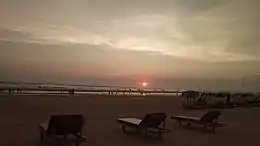 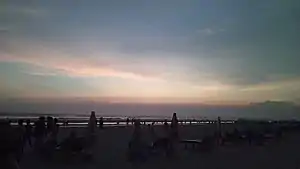  From top: Cox's Bazaar during sunset, Cox's Bazaar after sunset, Cox's Bazaar in daylight | |
| Coordinates: 21.4143°N 91.9832°E | |
| Country | |
| Division | Chittagong Division |
| District | Cox's Bazar District |
| Government | |
| • Body | Cox's Bazar Development Authority |
| Dimensions | |
| • Length | 150 km (90 mi) |
It is the largest sea beach in Asia
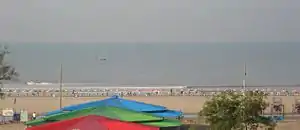
Geography
At high tide the beach is 200 metres (660 ft) wide and at low tide it is 400 metres (1,300 ft) wide on average.[7] Quicksand is a danger during ebb tide.[8]
History
From the early 9th century the greater Chittagong area, including Cox's Bazar, was under the rule of Arakan kings until its conquest by the Mughals in 1666 AD. When the Mughal Prince Shah Shuja was passing through the hilly terrain of the present-day Cox's Bazar on his way to Arakan, he was attracted to its scenic and captivating beauty. He commanded his forces to camp there. His retinue of one thousand palanquins stopped there for some time. A place named Dulahazara, meaning "one thousand palanquins," still exists in the area.
After the Mughals, the place came under the control of the Tipras and the Arakanese, followed by the Portuguese and then the British.
The name Cox's Bazar originated from the name of a British East India Company officer, Captain Hiram Cox, who was appointed as the Superintendent of Palonki (today's Cox's Bazar) outpost. He succeeded Warren Hastings, who became the Governor of Bengal following the British East India Company Act in 1773. Cox embarked upon the task of rehabilitation and settlement of the Arakanese refugees in the area.[9] He rehabilitated many refugees in the area, but died in 1799 before finishing his work. To commemorate him, a market was established and named after him, called Cox's Bazar. Cox's Bazar was first established in 1854 and became a municipality in 1869.
Just after the end of British rule in 1947, Cox's Bazar became part of East Pakistan. Captain Advocate Fazlul Karim, the first post-independence chairman of Cox's Bazar Municipality, established the Tamarisk Forest along the beach. He wanted to attract tourists as well as to protect the beach from tsunamis. He donated much of his father-in-law's and his own lands as sites for constructing a public library and a town hall. Karim was inspired to build Cox's Bazar as a tourist spot after seeing beaches of Bombay and Karachi, and was a resort pioneer in developing Cox's Bazar as a destination. Karim established a maternity hospital, the stadium and the drainage system by procuring grants from the Ford Foundation and Rockefeller Foundation through correspondence. T. H. Matthews, the principal of the Dacca Engineering College (1949~1954), was a friend who had helped him in these fundraising efforts. Engineer Chandi Charan Das was the government civil engineer who worked on all these projects.
Parts of the beach
Kolatoli Point

Kolatoli Point (Bengali: কলাতলী পয়েন্ট) is a part of Cox's Bazar beach situated near Dolphine Moure of Cox's Bazar city. Many hotel and restaurant are reside in this area. Buses stop near this point. Before restrictions of government, stoppage of bus was the beach area of Kolatoli. Now all bus stop near Dolphine moure.
Sugondha Point
Sugondha Point (Bengali: সুগন্ধা পয়েন্ট) situated from the north of Kolatoli point. There is a Burmese market that famous in Cox's bazar. There were sea food restaurants but demolished by government.[10]
Laboni Point
Laboni point (Bengali: লাবনী পয়েন্ট) is the famous part of the beach. People mainly gather mostly here. This part is best for surf, jog, cycle and swim.
Darianagar Beach
Darianagar (Bengali: দরিয়ানগর সৈকত) situated near Himchhori waterfall and hilltrack. It is a beach with waterways flowing through it.
Inani Beach
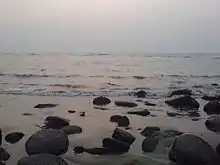
Inani Beach (Bengali: ইনানী সৈকত) is an 18-kilometre-long (11 mi) sea beach in Ukhia Upazila of Cox's Bazar District, Bangladesh.[11][12] It has a lot of coral stones, which are very sharp. These coral stones look black and green, and they are found in summer or rainy seasons.[13]
Teknaf Beach

Teknaf Beach (Bengali: টেকনাফ সৈকত) situated in Teknaf Upazila of Cox's bazar district. This is unlike of main part of the beach. Teknaf beach is more wild than main beach and surrounded by teknaf peninsula mangrove.[14] This beach is divieded by many sections. Mentionable sections are –
- Shamlapur Beach (Baharchara Beach)
- Shilakhali Beach
- Hajampara Beach[15]
Gallery
 Aerial view of Cox's Bazar Beach
Aerial view of Cox's Bazar Beach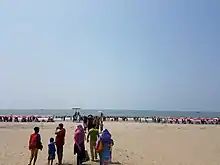 Beach Skyline
Beach Skyline People at Cox's Bazaar
People at Cox's Bazaar Sea Beach Area
Sea Beach Area Cox's Bazar Beach
Cox's Bazar Beach View of sea beach from umbrella
View of sea beach from umbrella Cox's Bazar sea beach parasailing
Cox's Bazar sea beach parasailing Beach area
Beach area
See also
References
- Ethirajan, Anbarasan (26 December 2012). "Bangladesh's Cox's Bazar: A paradise being lost?". BBC World. Retrieved 29 January 2015.
- "Bangladesh: Tourism". The Europa World Year Book. Taylor & Francis. 2003. p. 679. ISBN 978-1-85743-227-5.
- "Cox's Bazar, Bangladesh - the World's Longest Beach 120km". Retrieved 10 January 2008.
- "World's longest beach hidden in Bangladesh". The Sydney Morning Herald. Reuters. 31 January 2007. Retrieved 10 January 2008.
- IMF Country Report 05/410 Bangladesh: Poverty Reduction Strategy Paper. International Monetary Fund. 23 December 2005. p. 116. ISBN 978-1-4527-0752-5.
- Ajit K. Danda, Asia, Land and People, page 120, Asiatic Society (Kolkata), 2003, ISBN 9788172361402
- Mariam Whyte and Jui Lin Yong, Bangladesh, page 136, Marshall Cavendish, 2010, ISBN 9780761444756
- "43 died in Cox's Bazar sea beach in 13 years: 5-km beach net likely". Bangladesh Sangbad Sangstha. 17 March 2010. Archived from the original on 5 March 2016. Retrieved 1 November 2015.
- Nandita Haksar (2009). Rogue Agent: How India's Military Intelligence Betrayed the Burmese Resistance. Penguin Books India. pp. 55–56. ISBN 978-0-14-306489-3.
- "Court orders removal of 52-establishments at Sugandha Point". TBS News.
- Chowdhury, Towhid Hossain (2012). "Ukhia Upazila". In Islam, Sirajul; Jamal, Ahmed A. (eds.). Banglapedia: National Encyclopedia of Bangladesh (Second ed.). Asiatic Society of Bangladesh.
- "The Longest Walk begins in Cox's Bazar". Dhaka Tribune. 18 March 2017. Retrieved 3 April 2017.
- "A luxury resort opens in Cox's Bazar". The Daily Star. 12 February 2015. Retrieved 3 April 2017.
- "Teknaf Sea Beach: Complete Solitude On A Gorgeous Beach".
- "Shamlapur Sea Beach – Travel Guideline".